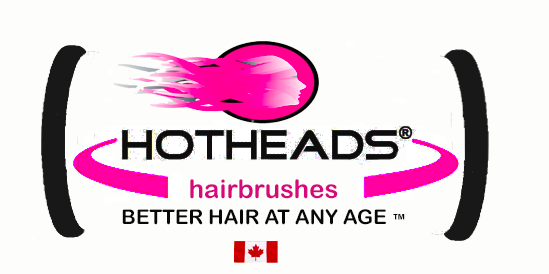
HELP PREVENT COLOR FADING when BLOW-DRYING
Work smarter not harder
Your styling brush and bristles do 90% of the work when blow drying , why not have a brush that offers more.
HOTHEADS® Patented Thermal Conductive Technology™ moderates the heat helping to prevent hot spots and severe heat damage from extremely hot dryers.
Evolving Hair Brush Technologies
Technologies are continually evolving in the hairbrush industry to improve ones’ styling experience.
- Coatings
- Marketing
- Blow-Drying and Heat
- Brush Shape and Design
- Handle Design, Balance and Ergonomics
- Bristle Pattern
Coatings
Negative Ions/Negative Ion Technology
First came various coatings which emitted negative Ions, which focused on a faster disbursement of water, reducing drying time and frizz. Removing the water that is needed for the structural integrity of the hair from being dry and brittle will result in hair color fading.
Tourmaline
Looking at other technologies like tourmaline which is used to produce infrared heat. Infrared heat has the ability to penetrate deeper into the shaft to speed up drying time. If the heat can penetrate deeper, it will cause more internal damage to the structural integrity of the hair. When considering excessive heat from the hair dryer it may just amplify the damage internally, trading speed for damage to the hair structure. Resulting in color fading.
Cooper
It has very good thermal conductivity allowing fast heating. Over time this approach can result in compounding the heat damage to the hair. Another factor to consider is the cooling stage of this element which is minimal, and we all know that cooling is what really sets hair. So, the time saved heating and drying is reduced when you have to wait longer to cool down and set hair.
Magnesium
Magnesium has reasonable thermal conductivity, but its major value is its very light weight. Most styling brushes are made with a hollow metal core making them light. so weight does not seem to be a problem. Is there a real value to magnesium?
Blow-Drying heating and cooling
The industry has now moved towards the hair blow-dryer brushes. The major issue with this tool is the user has little control of the excessive heat. You can adjust the heat to some degree, but they just do not work as well at lower temperatures as suggested. The problem here is they focus on heat when it is only one part of the drying and styling process.
The cool down process is more valuable in speeding up drying time by reducing the time a brush needs to cool. Heating faster only makes the hair pliable as it's drying. More important is the cooling stage as the cooling will contract the internal structure and this is what stabilizes the volume, curl, waves or smoothing when styling.
Brush Shape and Design
The design and shape of a brush should help improve the drying and styling experience. As the shape can help the hot air flow from the dryer more efficiently by controlling, channeling, and compressing the heat and air flow.
Handle Design, Balance and Ergonomics
A lighter weight brush in some cases maybe just a marketing strategy, but when you work with hair, the brush weight and balance should make it easier to style. For example when styling very thick curly hair while smoothing, some weight can be beneficial. When smoothing the weight will help reduce the energy in the thickness and curl, making it easier to smoothen. A brush with no weight means more effort on your part to smoothen the hair. Why would you use a brush that makes you work harder?
Bristle Pattern
The bristles are another feature both in the pattern and types of bristles used to improve performance. There are many variations of bristling, which include natural and synthetic fibers each with their own characteristics. The ability to have the hair slip and grip for tension when smoothing is one. Another is the ability to easily penetrate the hair allowing for adjustment with ease along the section. Without tension hair will not shape correctly as the stretching allows hair to retain a shape when styled. What is more important the tension, grip, or the slip? A combination of all three are important for improved performance.
Preventing color fading when blow-drying is a combination of both the hair brush and the hair dryer using smarter technologies.
